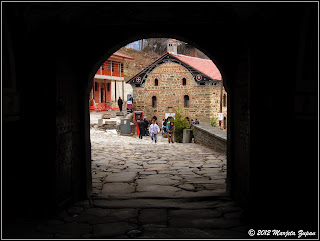As a mostly Orthodox country Bulgaria celebrated Easter last weekend and even though I'm not religious, I just couldn't say no when a friend of mine asked me if I wanted to celebrate Easter with her and her friends. Generally, there aren't any special events when it comes to celebrating Easter in Bulgaria. Usually, eggs are coloured on Holy Thursday or Saturday. People go to church on Saturday night and they walk around the church three times with lit candles. There's a saying that if your faith is strong enough, the candle won't be put out no matter how strong the wind is. After midnight and then on Easter Sunday people greet each other saying Christ has risen! Indeed he is risen! (Христос воскресе! Воистину воскресе!). After the service on Saturday night and on Easter Sunday people exchange Easter eggs and have an egg fight. Egg fight or egg tapping is a traditional Easter game. People tap Easter eggs against another egg and the unbroken egg wins. The tapping is then repeated with other eggs. The person that manages to break all other eggs without breaking his own egg, will be lucky and healthy until the next Easter. On Easter Sunday people mostly just have a special Easter lunch, but in some parts of Bulgaria celebrating Easter includes also some special festive customs. One of these parts is also Blagoevgrad Province, where I have been invited to and took part in some lovely local traditions.
Elešnica is a just little village close to Bansko (Blagoevgrad Province) with ca. 1,500 inhabitants, but every Easter locals from near-by villages are meeting here either to see or to take part in a special Easter tradition. More or less everyone in the village dresses up in national costumes and people dance traditional Bulgarian dances from one side of the village all the way up to the main square. Some people also dress up in goat-fur costumes with bells, similar to Slovenian kurent, and their job is to jump around, make a lot of noise and scare away the evil spirits. These costumes smell so bad that I'm sure the evil spirits were scared away just because of the smell. Anyway, as I was actively participating in the dancing tradition I was also dressed in a national costume and saying that I felt special is a bit of an understatement. Not only my friends, but also their relatives really made an effort to make me feel welcome and I have to say they are one of the warmest people I have ever met. Anyway, back to the dancing.
Bulgarian dances may seem easy to perform, but they sure aren't a piece of cake to learn. It can be quite tricky to catch the rhythm of the music and without the rhythm you are pretty much lost. However, for a non-Bulgarian I think I did actually quite well and hearing comments such as I'm really impressed cause you've picked up the steps so quickly and You dance like a Bulgarian felt pretty good (yes, I am boasting a bit and I am aware of the fact that these comments might have been exaggerated, but I've decided to believe they weren't). So, as mentioned, people dance through the village and when they finally get to the main square, there's still some dancing to do on the main square. As Elešnica is divided in quarters, each quarter forms its own dancing group and they compete against each other and basically, the one that dances the best, wins at the end. The dancing goes on the whole morning, until lunch, and in the end you feel quite tired. The music, which is played by a group of gypsies, gets a bit loud and the costume actually gets heavy around the waist. At such a point you try your best for the very last dance and after the winners of the day are announced, it's time to go home and have lunch. Traditionally, Bulgarians eat lamb for Easter. The last time I had lamb was some 15 years ago at my aunt's place (and I didn't really like it) and considering I'm very picky when it comes to meat, I was a bit sceptical about having lamb, but I actually loved it. Obviously prepared by a professional, this tender meat just melted in my mouth. Another traditional dish Bulgarians make for Easter is kozunak (козунак) - a kind of an Easter cake. It's basically very soft sweet bread, similar to Italian panettone. So goooood ...
I really had great fun the whole weekend, but I was a bit dead after lunch. Quickly, my Easter weekend came to an end as I had to get back to Sofia on Sunday night. My friends took me to the bus stop, which actually wasn't an official bus stop, but sort of an unofficial one in the middle of nowhere and even though it was just around 150 km to Sofia, the bus trip took three hours. It felt good to be back in Sofia, but I'm definitely coming back to Elešnica some day.









